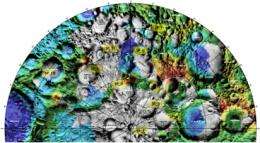LCROSS Selects Crater with Best Chance of Finding Water

NASA has identified the spot where it will search for water on the moon.
The announcement of the target location where the Lunar Crater Observation and Sensing Satellite, or LCROSS, and its spent Centaur rocket will hit in October, will take place on Friday, Sept. 11, at NASA's Ames Research Center in Moffett Field, Calif. The event will be broadcast live on NASA Television and the agency's Web site.
The selected crater is an optimal target for evaluating if water ice exists at the lunar south pole. Briefing participants are Daniel Andrews, LCROSS project manager, Anthony Colaprete, LCROSS principal investigator, and Jennifer Heldmann, lead for the LCROSS observation campaign.
Andrews will provide an update about the health of the spacecraft and mission activities. Colaprete will announce the target crater and explain the criteria and selection process. Heldmann will discuss the LCROSS observation campaign in which an international cadre of professional and amateur astronomers will view the impacts at 4:30 a.m. on Oct. 9.
For NASA TV streaming video, downlink and scheduling information, visit: www.nasa.gov/ntv
LCROSS launched with the Lunar Reconnaissance Orbiter (LRO) aboard an Atlas V rocket from Cape Canaveral, Fla., on June 18, 2009 at 2:32 p.m. PDT. The LCROSS shepherding spacecraft and the Atlas V’s Centaur upper stage rocket executed a fly-by of the moon on June 23, 2009 and entered into an elongated Earth orbit to position LCROSS for impact on a lunar pole. On final approach, the shepherding spacecraft and Centaur will separate. The Centaur will act as a heavy impactor to create a debris plume that will rise above the lunar surface. Projected impact at the lunar South Pole is currently: Oct 9, 2009 at 4:30 a.m. PDT. Following four minutes behind, the shepherding spacecraft will fly through the debris plume, collecting and relaying data back to Earth before impacting the lunar surface and creating a second debris plume.
The debris plumes are expected to be visible from Earth- and space-based telescopes 10-to-12 inches and larger.
The LCROSS science payload consists of two near-infrared spectrometers, a visible light spectrometer, two mid-infrared cameras, two near-infrared cameras, a visible camera and a visible radiometer. The LCROSS instruments were selected to provide mission scientists with multiple complimentary views of the debris plume created by the Centaur impact.
As the ejecta rises above the target crater’s rim and is exposed to sunlight, any water-ice, hydrocarbons or organics will vaporize and break down into their basic components. These components primarily will be monitored by the visible and infrared spectrometers. The near-infrared and mid-infrared cameras will determine the total amount and distribution of water in the debris plume. The spacecraft’s visible camera will track the impact location and the behavior of the debris plume while the visible radiometer will measure the flash created by the Centaur impact.



















